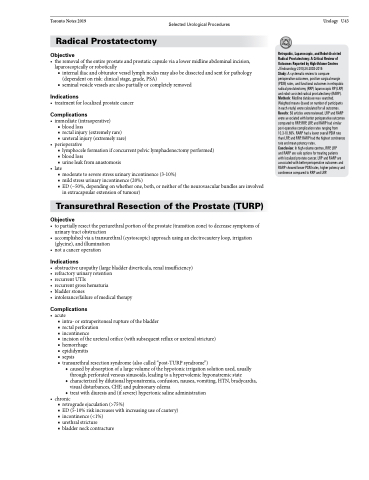Page 1361 - TNFlipTest
P. 1361
Toronto Notes 2019 Selected Urological Procedures Radical Prostatectomy
Objective
• theremovaloftheentireprostateandprostaticcapsuleviaalowermidlineabdominalincision, laparoscopically or robotically
■ internal iliac and obturator vessel lymph nodes may also be dissected and sent for pathology (dependent on risk: clinical stage, grade, PSA)
■ seminal vesicle vessels are also partially or completely removed
Indications
• treatmentforlocalizedprostatecancer
Complications
• immediate(intraoperative) ■ blood loss
■ rectal injury (extremely rare)
■ ureteral injury (extremely rare) • perioperative
■ lymphocele formation if concurrent pelvic lymphadenectomy performed) ■ blood loss
■ urine leak from anastomosis
• late
■ moderate to severe stress urinary incontinence (3-10%)
■ mild stress urinary incontinence (20%)
■ ED (~50%, depending on whether one, both, or neither of the neurovascular bundles are involved
in extracapsular extension of tumour)
Transurethral Resection of the Prostate (TURP)
Objective
• topartiallyresecttheperiurethralportionoftheprostate(transitionzone)todecreasesymptomsof urinary tract obstruction
• accomplishedviaatransurethral(cystoscopic)approachusinganelectrocauteryloop,irrigation (glycine), and illumination
• notacanceroperation
Indications
• obstructiveuropathy(largebladderdiverticula,renalinsufficiency) • refractoryurinaryretention
• recurrentUTIs
• recurrentgrosshematuria
• bladderstones
• intolerance/failureofmedicaltherapy
Complications
• acute
■ intra- or extraperitoneal rupture of the bladder
■ rectal perforation
■ incontinence
■ incision of the ureteral orifice (with subsequent reflux or ureteral stricture) ■ hemorrhage
■ epididymitis
■ sepsis
■ transurethral resection syndrome (also called “post-TURP syndrome”)
◆ caused by absorption of a large volume of the hypotonic irrigation solution used, usually through perforated venous sinusoids, leading to a hypervolemic hyponatremic state
◆ characterized by dilutional hyponatremia, confusion, nausea, vomiting, HTN, bradycardia, visual disturbances, CHF, and pulmonary edema
◆ treat with diuresis and (if severe) hypertonic saline administration • chronic
■ retrograde ejaculation (>75%)
■ ED (5-10% risk increases with increasing use of cautery) ■ incontinence (<1%)
■ urethral stricture
■ bladder neck contracture
Urology U43
Retropubic, Laparoscopic, and Robot-Assisted Radical Prostatectomy: A Critical Review of Outcomes Reported by High-Volume Centres J Endourology 2010;24:2003-2015
Study: A systematic review to compare perioperative outcomes, positive surgical margin (PSM) rates, and functional outcomes in retropubic radical prostatectomy (RRP) laparoscopic RP (LRP) and robot-assisted radical prostatectomy (RARP). Methods: Medline database was searched. Weighted means (based on number of participants in each study) were calculated for all outcomes. Results: 58 articles were reviewed. LRP and RARP were associated with better perioperative outcomes compared to RRP. RRP, LRP, and RARP had similar post-operative complication rates ranging from 10.3-10.98%. RARP had a lower overall PSM rate than LRP, and RRP. RARP had the highest continence rate and mean potency rates.
Conclusion: In high-volume centres, RRP, LRP
and RARP are safe options for treating patients with localized prostate cancer. LRP and RARP are associated with better perioperative outcomes and RARP showed lower PSM rates, higher potency and continence compared to RRP and LRP.


